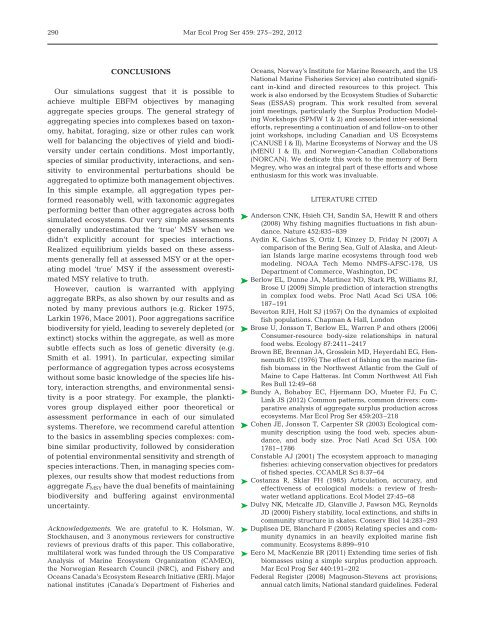Complete Theme Section in pdf format - Inter Research
Complete Theme Section in pdf format - Inter Research
Complete Theme Section in pdf format - Inter Research
Create successful ePaper yourself
Turn your PDF publications into a flip-book with our unique Google optimized e-Paper software.
290<br />
Mar Ecol Prog Ser 459: 275–292, 2012<br />
CONCLUSIONS<br />
Our simulations suggest that it is possible to<br />
achieve multiple EBFM objectives by manag<strong>in</strong>g<br />
aggregate species groups. The general strategy of<br />
aggregat<strong>in</strong>g species <strong>in</strong>to complexes based on taxonomy,<br />
habitat, forag<strong>in</strong>g, size or other rules can work<br />
well for balanc<strong>in</strong>g the objectives of yield and biodiversity<br />
under certa<strong>in</strong> conditions. Most importantly,<br />
species of similar productivity, <strong>in</strong>teractions, and sensitivity<br />
to environmental perturbations should be<br />
aggregated to optimize both management objectives.<br />
In this simple example, all aggregation types performed<br />
reasonably well, with taxonomic aggregates<br />
perform<strong>in</strong>g better than other aggregates across both<br />
simulated ecosystems. Our very simple assessments<br />
generally underestimated the ‘true’ MSY when we<br />
didn’t explicitly account for species <strong>in</strong>teractions.<br />
Realized equilibrium yields based on these assessments<br />
generally fell at assessed MSY or at the operat<strong>in</strong>g<br />
model ‘true’ MSY if the assessment overestimated<br />
MSY relative to truth.<br />
However, caution is warranted with apply<strong>in</strong>g<br />
aggregate BRPs, as also shown by our results and as<br />
noted by many previous authors (e.g. Ricker 1975,<br />
Lark<strong>in</strong> 1976, Mace 2001). Poor aggregations sacrifice<br />
biodiversity for yield, lead<strong>in</strong>g to severely depleted (or<br />
ext<strong>in</strong>ct) stocks with<strong>in</strong> the aggregate, as well as more<br />
subtle effects such as loss of genetic diversity (e.g.<br />
Smith et al. 1991). In particular, expect<strong>in</strong>g similar<br />
performance of aggregation types across ecosystems<br />
without some basic knowledge of the species life history,<br />
<strong>in</strong>teraction strengths, and environmental sensitivity<br />
is a poor strategy. For example, the planktivores<br />
group displayed either poor theoretical or<br />
assessment performance <strong>in</strong> each of our simulated<br />
systems. Therefore, we recommend careful attention<br />
to the basics <strong>in</strong> assembl<strong>in</strong>g species complexes: comb<strong>in</strong>e<br />
similar productivity, followed by consideration<br />
of potential environmental sensitivity and strength of<br />
species <strong>in</strong>teractions. Then, <strong>in</strong> manag<strong>in</strong>g species complexes,<br />
our results show that modest reductions from<br />
aggregate F MSY have the dual benefits of ma<strong>in</strong>ta<strong>in</strong><strong>in</strong>g<br />
biodiversity and buffer<strong>in</strong>g aga<strong>in</strong>st environmental<br />
uncerta<strong>in</strong>ty.<br />
Acknowledgements. We are grateful to K. Holsman, W.<br />
Stockhausen, and 3 anonymous reviewers for constructive<br />
reviews of previous drafts of this paper. This collaborative,<br />
multilateral work was funded through the US Comparative<br />
Analysis of Mar<strong>in</strong>e Ecosystem Organization (CAMEO),<br />
the Norwegian <strong>Research</strong> Council (NRC), and Fishery and<br />
Oceans Canada’s Ecosystem <strong>Research</strong> Initiative (ERI). Major<br />
national <strong>in</strong>stitutes (Canada’s Department of Fisheries and<br />
Oceans, Norway’s Institute for Mar<strong>in</strong>e <strong>Research</strong>, and the US<br />
National Mar<strong>in</strong>e Fisheries Service) also contributed significant<br />
<strong>in</strong>-k<strong>in</strong>d and directed resources to this project. This<br />
work is also endorsed by the Ecosystem Studies of Subarctic<br />
Seas (ESSAS) program. This work resulted from several<br />
jo<strong>in</strong>t meet<strong>in</strong>gs, particularly the Surplus Production Model<strong>in</strong>g<br />
Workshops (SPMW 1 & 2) and associated <strong>in</strong>ter-sessional<br />
efforts, represent<strong>in</strong>g a cont<strong>in</strong>uation of and follow-on to other<br />
jo<strong>in</strong>t workshops, <strong>in</strong>clud<strong>in</strong>g Canadian and US Ecosystems<br />
(CANUSE I & II), Mar<strong>in</strong>e Ecosystems of Norway and the US<br />
(MENU I & II), and Norwegian-Canadian Collaborations<br />
(NORCAN). We dedicate this work to the memory of Bern<br />
Megrey, who was an <strong>in</strong>tegral part of these efforts and whose<br />
enthusiasm for this work was <strong>in</strong>valuable.<br />
LITERATURE CITED<br />
Anderson CNK, Hsieh CH, Sand<strong>in</strong> SA, Hewitt R and others<br />
(2008) Why fish<strong>in</strong>g magnifies fluctuations <strong>in</strong> fish abundance.<br />
Nature 452: 835−839<br />
Ayd<strong>in</strong> K, Gaichas S, Ortiz I, K<strong>in</strong>zey D, Friday N (2007) A<br />
comparison of the Ber<strong>in</strong>g Sea, Gulf of Alaska, and Aleutian<br />
Islands large mar<strong>in</strong>e ecosystems through food web<br />
model<strong>in</strong>g. NOAA Tech Memo NMFS-AFSC-178, US<br />
Department of Commerce, Wash<strong>in</strong>gton, DC<br />
Berlow EL, Dunne JA, Mart<strong>in</strong>ez ND, Stark PB, Williams RJ,<br />
Brose U (2009) Simple prediction of <strong>in</strong>teraction strengths<br />
<strong>in</strong> complex food webs. Proc Natl Acad Sci USA 106:<br />
187−191<br />
Beverton RJH, Holt SJ (1957) On the dynamics of exploited<br />
fish populations. Chapman & Hall, London<br />
Brose U, Jonsson T, Berlow EL, Warren P and others (2006)<br />
Consumer-resource body-size relationships <strong>in</strong> natural<br />
food webs. Ecology 87: 2411−2417<br />
Brown BE, Brennan JA, Grossle<strong>in</strong> MD, Heyerdahl EG, Hennemuth<br />
RC (1976) The effect of fish<strong>in</strong>g on the mar<strong>in</strong>e f<strong>in</strong>fish<br />
biomass <strong>in</strong> the Northwest Atlantic from the Gulf of<br />
Ma<strong>in</strong>e to Cape Hatteras. Int Comm Northwest Atl Fish<br />
Res Bull 12: 49−68<br />
Bundy A, Bohaboy EC, Hjermann DO, Mueter FJ, Fu C,<br />
L<strong>in</strong>k JS (2012) Common patterns, common drivers: comparative<br />
analysis of aggregate surplus production across<br />
ecosystems. Mar Ecol Prog Ser 459:203–218<br />
Cohen JE, Jonsson T, Carpenter SR (2003) Ecological community<br />
description us<strong>in</strong>g the food web, species abundance,<br />
and body size. Proc Natl Acad Sci USA 100:<br />
1781−1786<br />
Constable AJ (2001) The ecosystem approach to manag<strong>in</strong>g<br />
fisheries: achiev<strong>in</strong>g conservation objectives for predators<br />
of fished species. CCAMLR Sci 8: 37−64<br />
Costanza R, Sklar FH (1985) Articulation, accuracy, and<br />
effectiveness of ecological models: a review of fresh -<br />
water wetland applications. Ecol Model 27: 45−68<br />
Dulvy NK, Metcalfe JD, Glanville J, Pawson MG, Reynolds<br />
JD (2000) Fishery stability, local ext<strong>in</strong>ctions, and shifts <strong>in</strong><br />
community structure <strong>in</strong> skates. Conserv Biol 14: 283−293<br />
Duplisea DE, Blanchard F (2005) Relat<strong>in</strong>g species and community<br />
dynamics <strong>in</strong> an heavily exploited mar<strong>in</strong>e fish<br />
community. Ecosystems 8: 899−910<br />
Eero M, MacKenzie BR (2011) Extend<strong>in</strong>g time series of fish<br />
biomasses us<strong>in</strong>g a simple surplus production approach.<br />
Mar Ecol Prog Ser 440: 191−202<br />
Federal Register (2008) Magnuson-Stevens act provisions;<br />
an nu al catch limits; National standard guidel<strong>in</strong>es. Federal
















